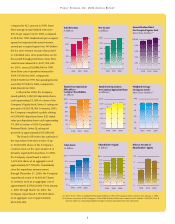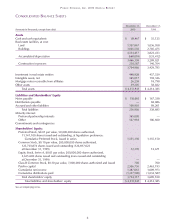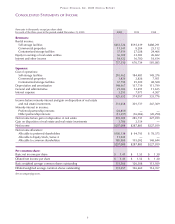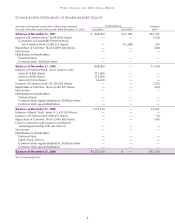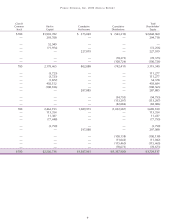Public Storage 2000 Annual Report Download - page 16
Download and view the complete annual report
Please find page 16 of the 2000 Public Storage annual report below. You can navigate through the pages in the report by either clicking on the pages listed below, or by using the keyword search tool below to find specific information within the annual report.
14
P
UBLIC
S
TORAGE
, I
NC
. 2000 A
NNUAL
R
EPORT
Environmental costs
Our policy is to accrue environmental assessments and/or remediation cost when it is probable that such efforts will be required and
the related costs can be reasonably estimated. Our current practice is to conduct environmental investigations in connection with
property acquisitions. Although there can be no assurance, we are not aware of any environmental contamination of any of our
facilities which individually or in the aggregate would be material to our overall business, financial condition, or results of operations.
Net income per common share
Basic net income per share is computed using the weighted average common shares (prior to the dilutive impact of stock options
outstanding). Diluted net income per common share is computed using the weighted average common shares outstanding (adjusted for
the dilutive impact of stock options outstanding). Commencing January 1, 2000, the Company’s 7,000,000 Class B common shares
outstanding began to participate in distributions of the Company’s earnings. Distributions per share of Class B common stock are equal to
97% of the per share distribution paid to the Company’s regular common shares. As a result of this participation in distribution of earnings,
for purposes of computing net income per common share, we began to include 6,790,000 (7,000,000 x 97%) Class B common shares in
the weighted average common equivalent shares for the year ended December 31, 2000. Weighted average shares for the years ended
December 31, 1999 and 1998 do not include any shares with respect to the Class B common stock as these shares did not participate in
distributions of the Company’s earnings prior to January 1, 2000. In addition, the inclusion of the convertible preferred stock (for periods
prior to conversion) in the determination of net income per common share has been determined to be anti-dilutive.
In computing earnings per common share, preferred stock dividends totaling $100,138,000, $94,793,000 and $78,375,000 for
the years ended December 31, 2000, 1999 and 1998, respectively, reduced income available to common stockholders in the
determination of net income allocable to common stockholders.
Net income allocated to our common shareholders has been further allocated among our two classes of common stock; our regular
common stock and our Equity Stock, Series A. The allocation among each class was based upon the two-class method. Under the two-class
method, earnings per share for each class of common stock is determined according to dividends declared (or accumulated) and participation
rights in undistributed earnings. Under the two-class method, the Equity Stock, Series A for the year ended December 31, 2000 was
allocated approximately $11,042,000 of net income and the remaining $185,908,000 was allocated to the regular common shares.
Stock-based compensation
In October 1995, the Financial Accounting Standards Board issued Statement No. 123 “Accounting for Stock-Based Compensation”
which provides companies an alternative to accounting for stock-based compensation as prescribed under APB Opinion No. 25 (APB
25). Statement 123 encourages, but does not require companies to recognize expense for stock-based awards based on their fair value
at date of grant. Statement No. 123 allows companies to continue to follow existing accounting rules (fair value method under APB 25)
provided that pro-forma disclosures are made of what net income and earnings per share would have been had the new fair value
method been used. We have elected to adopt the disclosure requirements of Statement No. 123 but will continue to account for
stock-based compensation under APB 25.
Reclassifications
Certain reclassifications have been made to the consolidated financial statements for 1999 and 1998 in order to conform to the
2000 presentation.
Note 3 —
Business Combinations
Mergers
On March 12, 1999, we completed a merger with Storage Trust Realty, Inc. (“Storage Trust”). All the outstanding stock of Storage Trust
was exchanged for 13,009,485 shares of the Company’s common stock and an additional 1,011,963 shares were reserved for issuance
upon conversion of limited partnership units in Storage Trust’s operating partnership. The aggregate acquisition cost of the merger was
approximately $575,676,000, consisting of the issuance of the Company’s common stock of approximately $347,223,000, cash of
approximately $105,239,000, the assumption of debt in the amount of $100,000,000, and the Company’s pre-existing investment
in Storage Trust of approximately $23,214,000.



